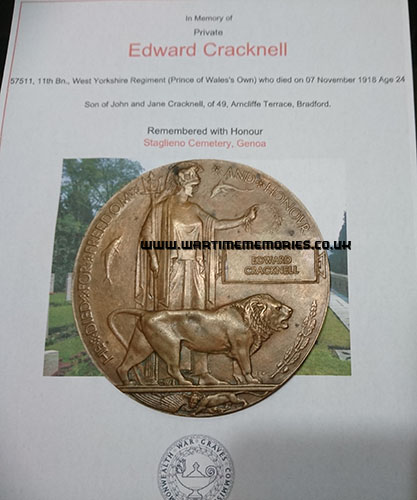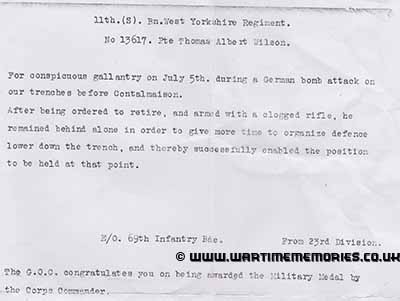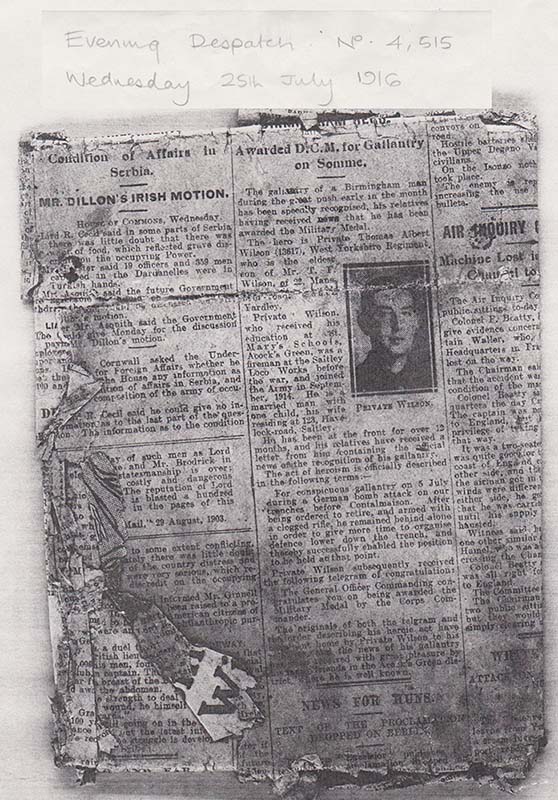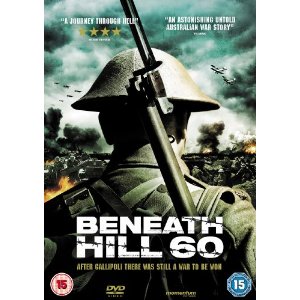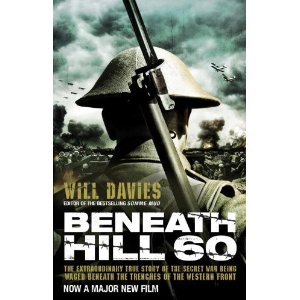|
|
|
11th Battalion, West Yorkshire Regiment
11th (Service) Battalion, West Yorkshire Regiment (Prince of Wales's Own) was formed at York, on 10th October 1914, as part of Kitchener's Third Army. They joined 69th Brigade, 23rd Division.
23rd Division was established in September 1914 as part of Kitchener's Third New Army, and concentrated in Hampshire in September with 68th Brigade at Bullswater. As the winter set in, the Division moved to Aldershot. At the end of February 1915 they moved to Shorncliffe, Kent, and some of the infantry were engaged in constructing defences to the south of London in April and May, before the Division moved to Bordon, Hampshire at the end of the month. They proceeded to France in the third week of August, landing at Boulogne and concentrating near Tilques. On the 5th of September 23rd Division became attached to III Corps, moving to the Merris-Vieux Berquin area, for trench familiarisation under the guidance of the 20th (Light) and 27th Divisions. They took over front line sector between Ferme Grande Flamengrie to the Armentieres-Wez Macquart road in their own right on the 14th. During the Battle of Loos CIII and CV Brigades RFA were in action attached to 8th Division. With 23rd Division holding the front at Bois Grenier, they were relieved from that sector at the end of January 1916 and Divisional HQ was established at Blaringhem with the units concentrated around Bruay for a period of rest. On the 3rd of March they returned to the front line, taking over a sector between the Boyau de l'Ersatz and the Souchez River from the French 17th Division, with the Artillery taking over an exposed position between Carency and Bois de Bouvigny where it was subjected to heavy shelling. In early March a Tunnelling Company was established and men with a background in mining were transferred from the ranks to the Royal Engineers. In Mid April they returned to Bruay area for rest until mid May when they again took over the Souchez-Angres front, just before the German Attack on Vimy Ridge on the 21st. The brunt of the attack fell on 47th (London) Division, to the right of 23rd Division and the 23rd Divisional Artillery went into action in support of the 47th. On the 1st of June the Artillery supported 2nd Division as they undertook operations to recover lost ground. On the 11th of June the 23rd Division Infantry moved to Bomy and the artillery to Chamblain Chatelain and Therouanne to begin intensive training for the Battles of the Somme. They were in action in The Battle of Albert including the capture of Contalmaison, The Battles of Bazentin Ridge, Pozieres, Flers-Courcelette, Morval and The Battle of Le Transloy including the capture of Le Sars. In 1917 they fought in The Battle of Messines, The Battles of the Menin Road, Polygon Wood and the The First and Second Battles of Passchendaele. In November 1917 the Division moved to Italy concentrating between Mantua and Marcaria before taking over the front line at the Montello on the 4th of December. In 1918 they were in action during the fighting on the Asiago Plateau and the Battle of Vittorio Veneto, including the passage of the Piave and the Monticano. At the Italian Armistice at 3pm on the 4th of November, the 23rd were midway between the Rivers Livenza and Meduna, east of Sacile. They moved to billets west of Treviso and demobilisation took place in January and February 1919.
10th Oct 1914 11th Battalion West Yorkshire Regiment raised 11th Battalion, West Yorkshire Regiment is raised at York on the 10th of October 1914 as part of Kitchener's Third New Army, they join 69th Brigade, 23rd Division.
26th Aug 1915 11th West Yorks proceed to France 11th Battalion, West Yorkshire Regiment proceed to France on the 26th of August 1915, landing at Le Havre.
11th Sep 1915 Last day of Derby Scheme Recruitment
16th Oct 1915 The Derby Scheme
1st Dec 1915 Derby Scheme Armlets
10th Jan 1916 Group System Reopens
9th February 1916 Call Ups
7th Jun 1917 Hill 60 retaken by 11th West Yorks 11th Battalion West Yorkshire Regiment re-capture hill 60 from the Germans in the Battle of Messines.
12th of April 1918 Enemy Advances 
If you can provide any additional information, please add it here.
|
| Want to know more about 11th Battalion, West Yorkshire Regiment? There are:12 items tagged 11th Battalion, West Yorkshire Regiment available in our Library There are:12 items tagged 11th Battalion, West Yorkshire Regiment available in our Library 
These include information on officers, regimental histories, letters, diary entries, personal accounts and information about actions during the Great War.
|
|
Those known to have served with11th Battalion, West Yorkshire Regiment during the Great War 1914-1918. - Allbrighton MM, Alfred. CSM. (d.20th Sep 1917)
- Atha John. Pte. (d.7th Jun 1917)
- Blenkinsop J. W.. Pte.
- Cracknell Edward. Pte. (d.7th Nov 1918)
- Green MM Robert. L/Cpl.
- Hands MM. William Henry. Sgt. (d.12th May 1917)
- Henzell John Gibson. Pte. (d.18th Sept 1917)
- Lawday Thomas Charles. Pte. (d.20th Sep 1917)
- McManus Henry. Pte (d.30th Sep 1917)
- McNally MM. James Joseph. L/Cpl. (d.29th Sept 1917)
- Perfect Ernest Duncan. Sgt. (d.7th June 1917)
- Riley Richard. Pte. (d.22nd Jul 1917)
- Robinson George. Pte. (d.4th July 1916)
- Round MM. Sidney. L/Cpl.
- Southworth Thomas. Pte (d.11th Jul 1916)
- Wilson DCM. MM. Thomas Albert. Pte.
- Wilson MM. Thomas Albert. Pte.
All names on this list have been submitted by relatives, friends, neighbours and others who wish to remember them, if you have any names to add or any recollections or photos of those listed,
please Add a Name to this List
Records of 11th Battalion, West Yorkshire Regiment from other sources.
|
|
The Wartime Memories Project is the original WW1 and WW2 commemoration website.

- 1st of September 2024 marks 25 years since the launch of the Wartime Memories Project. Thanks to everyone who has supported us over this time.
|
Want to find out more about your relative's service? Want to know what life was like during the Great War? Our
Library contains many many diary entries, personal letters and other documents, most transcribed into plain text.
|
Looking for help with Family History Research?
Please see Family History FAQ's
Please note: We are unable to provide individual research.
|
|
Can you help?
The free to access section of The Wartime Memories Project website is run by volunteers and funded by donations from our visitors.
If the information here has been helpful or you have enjoyed reaching the stories please conside making a donation, no matter how small, would be much appreciated, annually we need to raise enough funds to pay for our web hosting or this site will vanish from the web.
If you enjoy this site
please consider making a donation.
Announcements
- 26th Mar 2025
Please note we currently have a massive backlog of submitted material, our volunteers are working through this as quickly as possible and all names, stories and photos will be added to the site. If you have already submitted a story to the site and your UID reference number is higher than
265607 your submission is still in the queue, please do not resubmit.
Wanted: Digital copies of Group photographs, Scrapbooks, Autograph books, photo albums, newspaper clippings, letters, postcards and ephemera relating to the Great War. If you have any unwanted
photographs, documents or items from the First or Second World War, please do not destroy them. The Wartime Memories Project will give them a good home and ensure that they are used for educational purposes. Please get in touch for the postal address, do not sent them to our PO Box as packages are not accepted.
|
World War 1 One ww1 wwII greatwar great battalion regiment artillery
Did you know? We also have a section on World War Two. and a
Timecapsule to preserve stories from other conflicts for future generations.
|
|
|
Pte. Thomas Charles Lawday 11th Btn. West Yorkshire Regiment (d.20th Sep 1917) Thomas Lawday was killed in action on 20th of September 1917 in the Battle of Menin Road. Aged 38 years, his name is entered on the Tyne Cot Memorial as he has no known grave.
|
CSM. Alfred Allbrighton MM, 11th Btn. West Yorkshire Regiment (d.20th Sep 1917) Alfred Allbrighton is my great-great uncle. Born in Polesworth, Warwickshire, he joined 11th Battalion, The Prince of Wales' Own (West Yorkshire Regiment). He was killed on 20th of September 1917, and is remembered on the memorial wall at Tyne Cot, Belgium. There is no grave, as his body wasn't found. My son has visited Tyne Cot. The inscription states that Alfred "went over the top", the soldier next to him was shot, so Alfred picked him up and carried him back to the trench. On leaving the trench for a second time, Alfred was fatally shot. He was awarded the Military Medal.
|
Pte. Edward Cracknell 11th Btn. West Yorkshire Regiment (d.7th Nov 1918) Edward Cracknell served on the Italian Front and died of influenza a few days before the Armistice. He is buried at Staglieno Cemetery, Genoa.
|
Pte. J. W. Blenkinsop 11th Btn. West Yorkshire Regiment J W Blenkinsop served with the 11th West Yorkshire Regiment. Medical records show he had a dental problem and spent four days in a field hospital from 1st of August 1917.
|
Pte. Richard Riley 11th Btn. West Yorkshire Regiment (d.22nd Jul 1917) I've adopted this soldier by the project in Belgium "Coming World Remember Me". An art installation in Zillebeke near Ypres. 600,000 little statues were made by people. The statues represent the 600,000 casualties (dead and/or missing) on Belgian ground. Soldiers as well as civilians. Richard Riley is remembered with honour on the Menin Gate Memorial in Ypres.
|
L/Cpl. Sidney Round MM. 1st Btn. East Yorkshire Regiment My grandfather Sidney Round served from 1914-1919. His first unit was 11th Battalion, West Yorkshires. He was transferred to 9th West Yorkshires in time for the landings at Suvla Bay. He served there 'till they were pulled out to Imbros.
Then Egypt till they were shipped to France in July 1916. He was then transfered to the 1st Battalion, East Yorkshires on the Somme. In Sept 1916 he won the MM.
He suffered trench foot and gassing a number of times. He was sent to Passendale.
He was sent back to England to the Beverly Training Battalion. He ended up in ASC till he was demobed in 1919. His records show he was not the perfect soldier he got into trouble now and again like a lot of the men, but he was a brave soldier to have fought where he did and made it home
|
Pte. George Robinson 11th Battalion West Yorkshire Regiment (d.4th July 1916) George Robinson was in France for nine months before his death.
He was the eighth child of the eleven children born to Edward and Lizzie Robinson. He was born on 1st July 1894 in Boston Spa, Yorkshire. On the 1911 census when he was 16 he was living with his parents, twelve year old brother Arthur, ten year old brother Alfred and his occupation was butchers assistant.
He enlisted at York into the 11th Battalion, the West Yorkshire Regiment formed in September 1914 as part of Field Marshal Kitcheners massive recruiting campaign. In the summer of 1915 he was in training at Bramshott, before leaving for France at the end of August. Bramshott is a hamlet on the border of Hampshire and Surrey and during the first World War~ Tin Town grew up around it.
In May 1916 George wrote to his class leaders at Boston Spa Methodist Church
I have put myself fully into His hand, to use me as He will, as he knows what is best for me and I can face the dangers of war cheerfully
At the first Battle of the Somme, when so many soldiers perished, it was only the regular 1st and 2nd battalions of the West Yorkshire who fought. Georges battalion was behind the lines just north of Amien. On the 3rd July the Battalion relieved the 16th Royal Scots in Scots Redoubt and the adjacent trenches. The Battalion diary records that on the 4th July Attacked the enemys lines during the afternoon and obtained our objective. We were forced to retire, so fell back on our own lines
According to a history of the West Yorkshire there was constant bombing attacks by both sides but no important alteration of the line took place. However, nineteen soldiers died on that day all with their names recorded on The Thiepval Memorial as having no known grave including George just three days after his 22nd birthday.
|
Sgt. William Henry Hands MM. 11th Btn. West Yorkshire Regiment (d.12th May 1917) Do not know very much at all about William Hands except that in the 1911 census he was still living at home aged 16, with dad, George and mother, Ellen (his father was a house painter). He was working at Cadburys as a chocolate moulder. He died of his wounds and was buried in the Military Cemetery at Lijssenthoek, 10 miles west of Ieper nr Poperinge.
|
L/Cpl. Robert Green MM 11th Btn. West Yorkshire Regiment L/Cpl Robert Green was awarded the Military Medal. I am trying to find out his actions to win the MM, the date we do not know.
|
Pte. Thomas Albert Wilson MM. 11th Battalion West Yorkshire Regiment My Granddad was awarded the Military Medal and our family would like him to be recognised for this. His name was Thomas Albert Wilson. However, his number on the medal and the newspaper clipping are different, the medal says 12617 and the newspaper clipping says 13617. My Auntie has all the original documentation and the medal.
|
Pte. Thomas Albert Wilson DCM. MM. 11th. (Service) Btn. West Yorkshire Regiment Thomas Albert Wilson was my Grandfather and we have a clipping from the Evening Despatch Newspaper No. 4,515 from Wednesday 25th July 1916. It reads: Awarded D.C.M. for Gallantry on Somme...
I also have a copy of the telegram which reads: 11th. (S) Bn. West Yorkshire Regiment. No. 13617. Pte Thomas Albert Wilson. For the conspicuous gallantry on July 5th. during a German bomb attack on our trenches before Contalmaison. After being ordered to retire, and armed with a clogged rifle, he remained behind alone in order to give more time to organize defence lower down the trench, and thereby successfully enabled the position to be held at that point.
A member of my family is in posession of the Military Medal he received.
|
Recomended Reading.Available at discounted prices.
|
BENEATH HILL 60 tells the extraordinary true story of Oliver Woodward, the legendary Australian metal scientist. In 1916, Woodward faced the most difficult decision, ultimately having to separate from his new young love for the deadly carnage of the Western Front. On treacherous territory, behind the German enemy lines, Woodward and his secret platoon of Australian tunnelers face a suicidal battle to defend a leaking, tunnel system. A tunnel packed with enough high explosives to change the course of the War.
Hill 60: Ypres (Battleground Europe) Nigel Cave
The shell-ravaged landscape of Hill 60, some three miles south east of Ypres, conceals a labyrinth of tu nnels and underground workings. This book offers a guide to the memorials, cemeteries and museums at the site '
Beneath Hill 60 [Paperback] Will Davies
'Ten seconds, nine, eight, seven, six, five, four, three, two, one - fire! Down goes the firing switch. At first, nothing. Then from deep down there comes a low rumble, and it as if the world is spliting apart...' On 7th June 1917, nineteen massive mines exploded beneath Messines Ridge near Ypres. The largest man-made explosion in history up until that point shattered the landscape and smashed open the German lines. Ten thousand German soldiers died. Two of the mines - at Hill 60 and the Caterpillar - were fired by men of the 1st Australian Tunnelling Company, comprising miners and engineers rather than parade-ground soldiers. Drawing on the diaries of one of the key combatants, "Benealth Hill 60" tells the little-known, devastatingly brutal true story of this subterranean war waged beneath the Western Front - a stygian battle-ground where men drowned in viscous chalk, suffocated in the blue gray clay, choked on poisonous air or died in the darkness, caught up up in vicious hand-to-han
|
|
|





